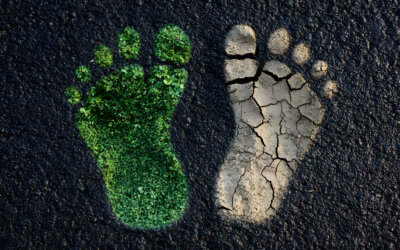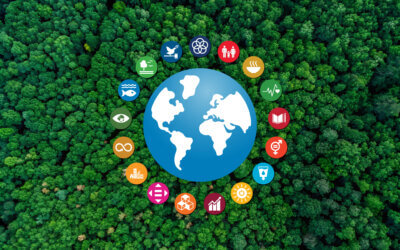Plastic water bottles are so popular around the world that around 1 million bottles are bought and sold every minute. According to some estimates, that number is expected to increase by another 20% by the year 2021. [1] That insatiable desire for water bottles is not without consequences, and the impact on the environment could cause irreparable damage to the planet. The good news is there is still time to change habits and reduce the carbon footprint of these popular single-use water bottles. Below, we will go over exactly why these bottles are harmful and different steps you can take to reduce their impact and begin to repair the planet.
What Is the Carbon Footprint of a Water Bottle?
According to some research, a 500-milliliter bottle of water has a total carbon footprint of about 3 ounces of carbon dioxide. [2] However, that number could change depending on many variables, including the manufacturer, transportation, and whether or not the bottle was ultimately recycled. Other factors that contribute to the total carbon footprint of a plastic water bottler include the following.
Raw Materials Distribution
The most common material used in beverages such as bottled water is polyethylene terephthalate or PET for short. PET raw materials come from crude oil and natural gas and account for around 10% of global annual oil usage. [3] Manufacturing this type of plastic can release more than carbon. Toxic emissions from PET manufacturing includes: [4]
- Benzene
- Ethylbenzene
- Ethylene oxide
- Nickel
Plastic Resins
The process of going from the raw materials to the finished bottle is similar to when PET was first synthesized by chemists at the DuPont chemical company in the 1940s. The PET is refined into resin pellets. This resin is then heated up until it becomes a liquid that can be molded into a variety of shapes, including bottles. [5]
Bottle Production
This manufacturing of bottled water requires a vast amount of resources, many of which are wasted. For every 8 ounces of bottled water you drink, about three times that much water was wasted during the production process. Likewise, making bottled water requires a lot of energy, in some cases, up to 2,000 times more energy compared to tap water. [6]
Packaging
Bottled water is the most popular beverage sold in the United States, with over $18 billion in annual sales. [7] This level of popularity has produced an ever-growing packaging problem as consumers have begun to demand alternatives to single-use plastic bottles. As a start, many manufacturers are moving to 100% recyclable packaging materials. [8]
Storage
In addition to being bad for the environment, water stored in plastic bottles may also harm your health. Plastic bottles contain chemicals that have the potential to leach into the water before you have a chance to drink it. When bottles are stored at high temperatures, the risk increases, and could ultimately lead to you drinking harmful endocrine-disrupting chemicals that can have a negative effect on your overall health. [9]
Eco-Friendly Alternatives to Plastic Water Bottles
If you are concerned about the health and safety of the planet and your body, then there are many alternatives to single-use plastic water bottles that will cut down on waste–and may even save you some money!
More Water, Fewer Emissions
Below are a few of the best ways you can increase your water consumption while reducing your environmental impact.
- Switch to a reusable glass that is 100% recyclable.
- Use a stainless steel bottle for more durability.
- Buy plant-based plastic bottles that are biodegradable.
- Drink filtered tap water from your home or business.
Does Recycling Help With the Carbon Footprint of Water Bottles?
If you do purchase plastic water bottles, then you should do your best to recycle them. Recycling is better for the environment and reduces a potential carbon footprint. By keeping your trash out of landfills and incinerators, you are helping reduce greenhouse gas (GHG) emissions. One study showed a 79% reduction of CO2 emissions of recycled PET plastics when compared to the production of new materials. [10]
What are Ways to Reduce Your Water Bottle Carbon Footprint?
While the worldwide consumption of bottled water leaves a significant carbon footprint, it is entirely avoidable, and with some proper planning and forethought, you can eliminate your contribution. Below are a few simple ways you can get started.
Skip Imported Bottled Water
With clean drinking water available in most parts of the world, importing it makes little sense for the environmentally conscious individual. Bottled water is heavy, and shipping it across the ocean can increase the carbon footprint dramatically. If you care about the carbon footprint of your beverages, buy local whenever possible and skip water that was bottled in another hemisphere.
Buy Plastic Bottle Alternatives
If you do buy your water at the store, then you may want to opt for plastic alternatives. Boxed water and water that comes packaged in plant-based plastics are becoming more mainstream and can help you avoid the environmental cost of more plastics.
Switch to a Multi-Use Bottle
The average American drinks around 36 gallons of bottled water every year. [11] By switching to a multi-use bottle, you alone could save hundreds of plastic bottles from the landfill each year.
Drink Filtered Tap Water
While switching up the kind of bottle you drink from goes a long way, to really make a positive impact, you may consider switching the kind of water you are drinking as well. Filtering your tap water at home can provide you with high-quality water that is cheaper and better for the environment. [12]
Offset Your Water Bottle Carbon Footprint
Whether it is while you are traveling or you need to stock a break room fridge at work, chances are you will not be able to cut out plastic bottles from your life entirely. For these moments, there is still a way to offset your impact. Purchasing carbon offsets, like those offered by Terrapass, will help reduce your carbon footprint. To learn more about your carbon footprint, explore our free carbon footprint calculator today.
Brought to you by terrapass.com
SOURCES:
- Laville, Sandra, and Matthew Taylor. “A Million Bottles a Minute: World’s Plastic Binge ‘as Dangerous as Climate Change’.” The Guardian, Guardian News and Media, 28 June 2017, www.theguardian.com/environment/2017/jun/28/a-million-a-minute-worlds-plastic-bottle-binge-as-dangerous-as-climate-change.
- Blue, Marie-Luise. “What Is the Carbon Footprint of a Plastic Bottle?” Sciencing, 2 Mar. 2019, sciencing.com/carbon-footprint-plastic-bottle-12307187.html.
- PET Resin Association. “PET – WHAT IS IT AND WHERE DOES IT COME FROM?” https://www.petresin.org/pdf/PET_whatisitandwheredoesitcomefrom.pdf.
- “PTF: ENVIRONMENTAL IMPACTS.” Ecology Center, ecologycenter.org/plastics/ptf/report3/.
- “FAQs – Frequently Asked Questions.” FAQs | PETRA: Information on the Use, Benefits & Safety of PET Plastic., www.petresin.org/faq.asp.
- “The Environmental Impacts of Plastic Water Bottles.” Go Green, www.gogreen.org/blog/impacts-of-plastic-water-bottles.
- “Bottled Water.” International Bottled Water Association, www.bottledwater.org/consumers-reaffirm-bottled-water-america%E2%80%99s-favorite-drink.
- Siegner, Cathy. “Packaging Challenges Could Leave Bottled Water Companies All Wet.” Food Dive, 2 Jan. 2019, www.fooddive.com/news/packaging-challenges-could-leave-bottled-water-companies-all-wet/544275/.
- Sax, Leonard. “Polyethylene Terephthalate May Yield Endocrine Disruptors.” Environmental Health Perspectives, National Institute of Environmental Health Sciences, Apr. 2010, www.ncbi.nlm.nih.gov/pmc/articles/PMC2854718/.
- “Alexandra Dittrich.” ALPLA Blog, blog.alpla.com/en/press-release/newsroom/study-confirms-excellent-carbon-footprint-recycled-pet/08-17.
- “Bottled Water.” International Bottled Water Association, www.bottledwater.org/bottled-water-%E2%80%93-nation%E2%80%99s-healthiest-beverage-%E2%80%93-sees-accelerated-growth-and-consumption.
- “Tap Water vs. Bottled Water.” Food & Water Watch, 2 Mar. 2018, www.foodandwaterwatch.org/about/live-healthy/tap-water-vs-bottled-water.







